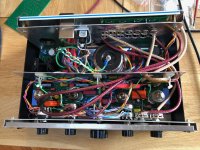Use what you have, say 0.5 µF or something, even 0.1 µF will be OK.
400 V rated caps are sufficient.
400 V rated caps are sufficient.
You've nailed it, MarcelvdG. When I built he preamp I used a 250k pot instead of a 500k one, after I was advised it would make no difference. I'll change it for a 500k one and see where that gets me.
Thank you.
Actually I've just opened it up and the volume pot is 100k, so well below the 500k specced.
Thanks, as_audio - I'll swap the pot first and see where that gets me.
Good point, C4 is indeed rather small, especially when the potmeter resistance is only 100 kohm. I think willholmania should change both C4 and P1 and if needed R5 and/or R6.
So you need even more coupling capacitance and effective plate load is only about half - less gain.
Aren't we beating a dead horse here? As said above, the design basically resembles an inverting opamp stage, but with rather limited open loop gain of the active component and huge output impedance. It's performance heavily depends on the properties of the tube (ageing, production tolerances) and (!) the cartridge, which is part of the NFB loop.
With due respect, this design was less than mediocre even in the 1950ies when Philips published it.
Best regards!
With due respect, this design was less than mediocre even in the 1950ies when Philips published it.
Best regards!
Okay - I took out the 100k volume pot and replaced it with a 500k part. The preamp works much better now, with a much fuller sound. Initial impressions are that it ain't great, but the between two stools output of the damn DL 110 cartridge is muddying the water. With my head amp inline the signal is now far too loud, and sends everything into chronic distortion. Without it, the signal's still a bit weak.
I've picked up a used Nad PP-1 phono stage on eBay so I'll at least have something to compare it with, but I suspect it's going to disappoint. Still, at least it works as well as it, er, does.
It's all good learning.
Now looking for a decent phono stage to build...
I've picked up a used Nad PP-1 phono stage on eBay so I'll at least have something to compare it with, but I suspect it's going to disappoint. Still, at least it works as well as it, er, does.
It's all good learning.
Now looking for a decent phono stage to build...
Did you change C4 also ? Still recommended.
I suggested in post 35 to use the existing Jfet
tape out "line amp" as simple MC head. Scale
the resistors down to say 50 and 500 Ω and add
an input resistor of 47kΩ which is missing here.
I suggested in post 35 to use the existing Jfet
tape out "line amp" as simple MC head. Scale
the resistors down to say 50 and 500 Ω and add
an input resistor of 47kΩ which is missing here.
Okay - I'll change C4. I can also scale back the gain of my little head amp - probably easier to do than using the line out section. I also have a hum problem I need to sort, as that's hardly helping the sound.
- Home
- Amplifiers
- Tubes / Valves
- More gain from EF86 RIAA preamp
